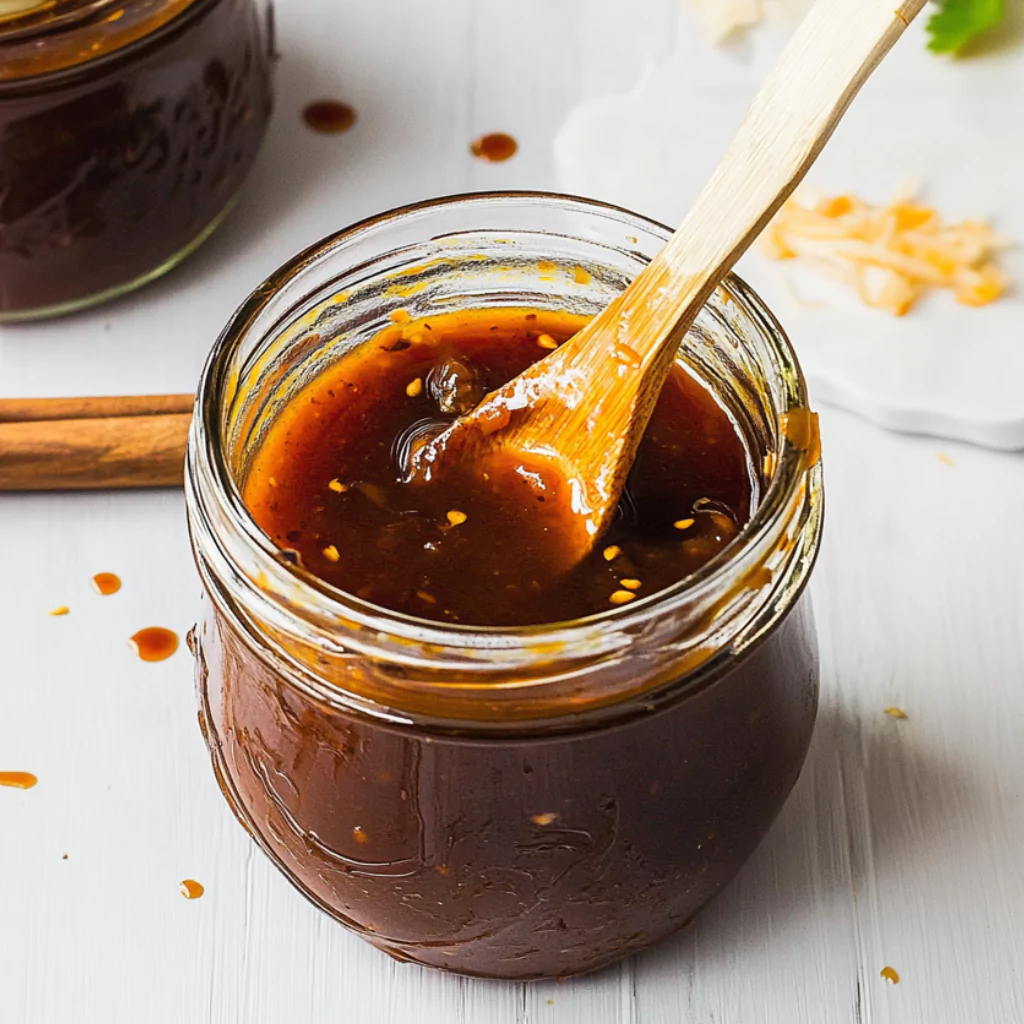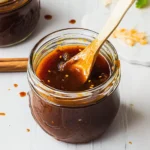General Tso Sauce is a bold, sweet, savory, and slightly spicy sauce commonly used in Chinese-American cuisine. It is best known for its role in General Tso’s Chicken, but it also makes a fantastic glaze for meats, a dipping sauce, or a stir-fry base. Making this sauce at home allows for customization of sweetness, spice, and sodium levels while ensuring the freshest ingredients.

Many store-bought versions contain preservatives, artificial flavors, and excessive sugar, which is why homemade General Tso Sauce is a healthier, more flavorful alternative. Plus, with the right ingredients and techniques, you can easily achieve a restaurant-quality taste.
History and Cultural Significance
Despite its popularity in Chinese restaurants worldwide, General Tso’s Chicken and its signature sauce did not originate in China. The dish was created by chefs catering to Western tastes, particularly in North America. The sauce itself follows the general principles of Chinese cuisine by balancing sweet, salty, sour, and umami flavors.
Some credit the dish to Chef Peng Chang-kuei, a Hunanese chef who later adapted his original recipe to suit the American palate. Others claim that while the dish bears the name of a famous Qing Dynasty military leader, General Tso, there is no direct historical connection between the two. Regardless of its origins, the sauce remains a staple in Chinese-American cooking.
Preparation Phase & Tools to Use
Essential Tools and Equipment
- Mixing Bowl – For combining wet and dry ingredients.
- Saucepan – A small saucepan works best for thickening the sauce.
- Whisk – Helps incorporate cornstarch and prevents lumps.
- Measuring Cups and Spoons – Ensures precise ingredient ratios.
- Garlic Press (Optional) – For freshly minced garlic without the hassle.
- Microplane Grater – Useful for grating fresh ginger.
Importance of Each Tool
Each piece of equipment plays a role in the sauce-making process. A saucepan allows controlled heat distribution, preventing the sauce from burning. A whisk is necessary for even blending, ensuring smooth consistency. Measuring cups and spoons help maintain flavor balance, while a garlic press and grater make preparation quicker and more efficient.
Preparation Tips
- Use fresh ingredients – Fresh ginger and garlic add depth to the sauce.
- Adjust thickness as needed – If the sauce is too thick, add water or broth.
- Simmer gently – High heat can cause the sauce to burn or become too thick too quickly.
- Taste as you go – Balancing flavors is key; tweak sweetness and spice levels to your preference.
- Make ahead of time – Letting the sauce sit for an hour before use enhances its depth of flavor.
Ingredients List
- ½ cup low-sodium soy sauce – Base for umami and saltiness.
- ¼ cup rice vinegar – Adds acidity to balance sweetness.
- 3 tablespoons hoisin sauce – Provides depth and a slightly tangy note.
- ¼ cup brown sugar – Sweetness that balances the salty and sour flavors.
- 1 tablespoon honey (optional) – Adds additional richness.
- 1 teaspoon fresh grated ginger – Essential for warmth and depth.
- 2 cloves garlic, minced – Enhances aroma and flavor.
- ½ teaspoon red pepper flakes – Adds subtle heat.
- 1 teaspoon sriracha (optional) – For extra spice.
- ½ cup water – Helps thin the sauce.
- 1 tablespoon cornstarch mixed with 2 tablespoons water – Thickening agent for the perfect consistency.
- 1 teaspoon sesame oil – Adds a slight nuttiness.
Step-by-Step Instructions
Cooking the Sauce
- Prepare the Ingredients – Measure all ingredients before starting to ensure a smooth cooking process.
- Mix the Cornstarch Slurry – In a small bowl, combine cornstarch with water. Stir until fully dissolved.
- Heat the Saucepan – Set the saucepan over medium heat and add sesame oil.
- Sauté Garlic and Ginger – Stir frequently for about 30 seconds until fragrant, being careful not to burn.
- Combine Liquids and Sugar – Add soy sauce, rice vinegar, hoisin sauce, brown sugar, honey, and water. Stir well to dissolve the sugar.
- Simmer Gently – Allow the sauce to simmer for 3–4 minutes, stirring occasionally.
- Add Heat Elements – Stir in red pepper flakes and sriracha (if using). Adjust spice level to preference.
- Thicken with Cornstarch Slurry – Gradually pour in the slurry while whisking constantly to prevent lumps.
- Cook Until Thickened – Continue stirring until the sauce thickens to the desired consistency (about 1–2 minutes).
- Taste and Adjust – Adjust seasoning by adding more sugar for sweetness or vinegar for acidity.
Alternative Cooking Methods
Microwave Method
For a quick and easy version, combine all ingredients except the cornstarch slurry in a microwave-safe bowl. Microwave in 30-second intervals, stirring in between, until the sugar dissolves. Add the cornstarch slurry and heat for another 30 seconds until thickened.
Slow Cooker Version
For a deeper, more developed flavor, mix all ingredients in a slow cooker and cook on low for 2 hours. Stir in the cornstarch slurry during the last 30 minutes of cooking.
Air Fryer Glaze
To use General Tso Sauce as a glaze for air-fried dishes, brush it over meat or tofu during the last few minutes of cooking to allow the sauce to caramelize.
Best Side Dishes to Serve with General Tso Sauce
A great sauce deserves the perfect accompaniments. Whether you’re making General Tso’s Chicken, tofu, or a stir-fry, these side dishes will complement the rich, sweet, and spicy flavors of the sauce.
1. Stir-Fried Vegetables
A mix of vibrant, crisp-tender vegetables enhances the dish. Broccoli, bell peppers, snow peas, and carrots provide crunch and color. Toss them in a hot wok with a little sesame oil, garlic, and a splash of soy sauce.
2. Fried Rice
General Tso’s Sauce pairs beautifully with fried rice. Use day-old rice for the best texture, and stir-fry it with eggs, scallions, peas, and carrots. Adding a drizzle of General Tso Sauce to the rice gives it a delightful sweet-savory kick.
3. Lo Mein Noodles
Lo mein noodles absorb sauces well, making them a great base for this dish. Sauté them with sesame oil, soy sauce, and garlic, then toss with your favorite vegetables and protein.
4. Steamed Dumplings
Soft, pillowy dumplings are excellent with General Tso Sauce as a dipping sauce. Pork, chicken, or vegetable dumplings all work well.
5. Crispy Egg Rolls
The crunch of egg rolls balances the saucy richness of the dish. Serve them with a side of General Tso Sauce for dipping.
6. Asian Pickled Cucumbers
Tangy, slightly sweet pickled cucumbers cleanse the palate and offer a refreshing contrast to the bold flavors of General Tso Sauce.
7. Wonton Soup
A light broth with delicate wontons serves as a comforting side that won’t overpower the sauce.
8. Steamed Jasmine Rice
Sometimes, simple is best. Jasmine rice is fluffy and neutral, allowing General Tso Sauce to shine.
Nutritional Information & Health Benefits
Calories and Macronutrients
General Tso Sauce is high in flavor but can also be high in sugar and sodium. A standard serving of two tablespoons contains:
- Calories – Around 50-80
- Carbohydrates – 10-15g (mostly from sugar)
- Protein – 1-2g
- Fat – 1-2g (from sesame oil)
Low-Sodium Adaptations
To reduce sodium, use:
- Low-sodium soy sauce or tamari
- Coconut aminos as a soy-free option
- Additional vinegar and citrus juice to enhance flavor without extra salt
Lower Sugar Options
To cut down on sugar:
- Replace brown sugar with a sugar substitute like monk fruit or erythritol
- Use honey or maple syrup for a more natural sweetener
Gluten-Free Adaptation
To make General Tso Sauce gluten-free, use tamari or coconut aminos instead of soy sauce. Also, check that the hoisin sauce you use is certified gluten-free.
Common Mistakes & How to Perfect the Sauce
1. Over-Thickening the Sauce
Too much cornstarch can turn the sauce into a gel-like texture. Always start with a small amount and add more if needed. If the sauce gets too thick, add water or broth to loosen it.
2. Using Low-Quality Soy Sauce
The quality of your soy sauce dramatically affects the final flavor. Low-quality brands can make the sauce too salty without depth. Use a premium soy sauce for the best taste.
3. Not Balancing Flavors
General Tso Sauce is all about balance. If it’s too sweet, add more vinegar. If it’s too salty, dilute it with a little water. If it lacks depth, add a touch more hoisin sauce.
4. Burning the Garlic and Ginger
Since garlic and ginger cook quickly, sauté them over medium-low heat to avoid bitterness.
5. Cooking at Too High a Heat
High heat can cause the sugars in the sauce to caramelize too quickly, leading to a burnt taste. Simmer on medium-low to maintain smooth consistency.
6. Adding Cornstarch Too Late
The cornstarch slurry should be added while the sauce is still simmering to ensure even thickening. Adding it too late can lead to clumps.
7. Overcomplicating the Recipe
Stick to the essential ingredients first before making modifications. Once you master the classic version, experiment with different flavors and adjustments.
Tips for Storing and Reheating General Tso Sauce
Refrigeration
Homemade General Tso Sauce stays fresh in the refrigerator for up to one week when stored properly. Keep it in an airtight glass jar or container to maintain its freshness. Shake or stir before use, as the cornstarch may cause slight separation.
Freezing Tips
For long-term storage, General Tso Sauce freezes well. Pour it into an ice cube tray or a freezer-safe container and freeze for up to three months. When ready to use, thaw overnight in the refrigerator or heat directly from frozen.
Reheating Techniques
To reheat General Tso Sauce, use low to medium heat on the stovetop. Add a splash of water or broth if it becomes too thick. Avoid microwaving at high heat, as this can cause uneven reheating and alter the sauce’s texture.
Variations & Creative Uses
Spicy Version
For extra heat, add chili oil, fresh red chilies, or Sichuan peppercorns. A dash of cayenne pepper can also intensify the spice level.
Sweet & Sour Version
For a tangy twist, replace part of the brown sugar with pineapple juice or orange zest. This variation works well as a glaze for grilled chicken or shrimp.
Peanut Butter Twist
For a nutty, creamy flavor, mix in 1-2 tablespoons of peanut butter. This version pairs well with noodles and tofu dishes.
Keto-Friendly Adaptation
For a low-carb version, substitute brown sugar with monk fruit sweetener or erythritol. Also, use coconut aminos instead of soy sauce to reduce carbs further.
Vegan Alternative
General Tso Sauce is naturally vegan, but if substituting honey, use maple syrup or agave nectar instead.
Dipping Sauce
Thicken the sauce slightly more with extra cornstarch to use as a dip for egg rolls, dumplings, or crispy tofu.
Marinade for Meats & Tofu
Use General Tso Sauce as a marinade for chicken, beef, shrimp, or tofu before cooking. Let it sit for at least 30 minutes for deeper flavor absorption.
Frequently Asked Questions (FAQs)
1. Can I make General Tso Sauce ahead of time?
Yes! It stores well in the fridge for a week and can be frozen for up to three months.
2. How can I make the sauce less spicy?
Reduce or omit the red pepper flakes and sriracha. Adding a little extra brown sugar or honey can also mellow out the heat.
3. What’s the difference between General Tso Sauce and Orange Sauce?
General Tso Sauce has a spicier, more savory profile, while orange sauce is sweeter and more citrusy.
4. Can I make this sauce without hoisin?
Yes! Substitute hoisin sauce with a mix of soy sauce, peanut butter, and a bit of molasses for a similar umami depth.
5. Is this sauce gluten-free?
Not by default, but you can make it gluten-free by using tamari or coconut aminos instead of soy sauce and checking that your hoisin sauce is gluten-free.
6. Can I use this sauce for meal prep?
Absolutely! It works great for weekly meal prep and can be used for quick stir-fries, marinades, and dipping sauces.
7. What meats pair best with General Tso Sauce?
This sauce is most commonly used with chicken, but it also works well with shrimp, beef, pork, and even tofu.
8. How do I prevent the sauce from becoming too thick?
If it thickens too much after cooling, add a splash of water or broth and reheat gently on the stovetop.
9. Can I make this sauce without cornstarch?
Yes! Arrowroot powder, tapioca starch, or xanthan gum can be used as alternatives for thickening.
10. Does General Tso Sauce contain MSG?
Traditional recipes do not include MSG, but some store-bought versions might. Making it at home allows full control over the ingredients.
Conclusion
Homemade General Tso Sauce is a flavorful and versatile addition to any kitchen. Whether used as a stir-fry sauce, glaze, or dipping sauce, it delivers the perfect balance of sweet, savory, and spicy flavors. By making it at home, you can adjust the ingredients to fit your taste and dietary preferences.
Try experimenting with different variations and pairings to find your perfect combination. With the right techniques, you can enjoy a restaurant-quality sauce anytime, straight from your kitchen! 🚀

Homemade General Tso Sauce
- Total Time: 10 minutes
- Yield: About ¾ cup of sauce 1x
- Diet: Vegan
Description
General Tso Sauce is a rich, flavorful, and versatile sauce commonly used in Chinese-American cuisine. This homemade version allows you to control the sweetness, spice, and sodium levels while using fresh ingredients for the best taste.
Ingredients
- ½ cup low-sodium soy sauce
- ¼ cup rice vinegar
- 3 tablespoons hoisin sauce
- ¼ cup brown sugar
- 1 tablespoon honey (optional, for extra sweetness)
- 1 teaspoon fresh grated ginger
- 2 cloves garlic, minced
- ½ teaspoon red pepper flakes (adjust for spice level)
- 1 teaspoon sriracha (optional, for extra heat)
- ½ cup water
- 1 tablespoon cornstarch + 2 tablespoons water (for thickening)
- 1 teaspoon sesame oil (for added depth of flavor)
Instructions
Step 1: Prepare Ingredients
- Measure all ingredients before starting to ensure a smooth cooking process.
- Mix the cornstarch and water in a small bowl to create a slurry.
Step 2: Sauté the Aromatics
- Heat sesame oil in a small saucepan over medium heat.
- Add minced garlic and grated ginger, stirring for 30 seconds until fragrant.
Step 3: Combine the Sauce Base
- Pour in soy sauce, rice vinegar, hoisin sauce, brown sugar, honey, and water.
- Stir well to dissolve the sugar and combine the flavors.
Step 4: Simmer the Sauce
- Allow the sauce to simmer for 3-4 minutes, stirring occasionally.
- Add red pepper flakes and sriracha, adjusting to your preferred spice level.
Step 5: Thicken the Sauce
- Stir the cornstarch slurry to ensure it’s fully mixed.
- Slowly pour it into the simmering sauce, whisking constantly.
- Continue cooking for 1-2 minutes until the sauce thickens to the desired consistency.
Step 6: Taste and Adjust
- If the sauce is too thick, add a splash of water.
- If it’s too sweet, add a little extra vinegar.
- If it’s too spicy, balance it out with more honey or brown sugar.
Step 7: Serve or Store
- Use immediately as a stir-fry sauce, glaze, or dipping sauce.
- Let it cool and store in an airtight container in the refrigerator for up to 1 week.
Notes
- For a spicier version, increase the red pepper flakes or add chili oil.
- For a milder sauce, reduce the sriracha and omit the red pepper flakes.
- To make it gluten-free, use tamari or coconut aminos instead of soy sauce.
- For a low-carb/keto version, substitute brown sugar with monk fruit sweetener.
- If the sauce gets too thick after storing, reheat it with a little water or broth.
- Prep Time: 5 minutes
- Cook Time: 5 minutes
- Category: Sauces & Condiments
- Method: Stovetop
- Cuisine: Chinese-American
Nutrition
- Calories: 50-80
- Sugar: 10g
- Sodium: Varies based on soy sauce choice
- Fat: 1-2g
- Saturated Fat: 0.2g
- Carbohydrates: 10-15g
- Fiber: 0.5g
- Protein: 1-2g




Leave a Comment